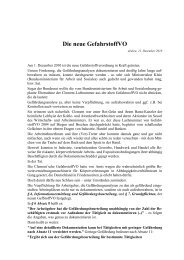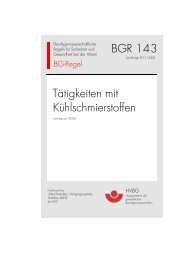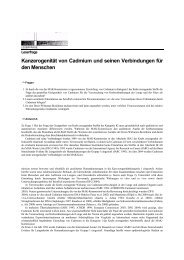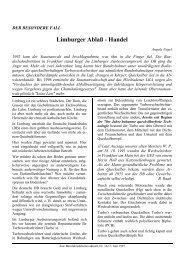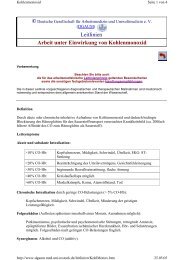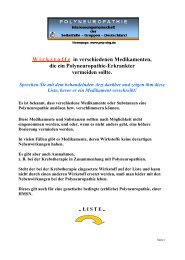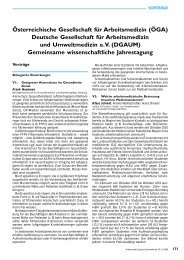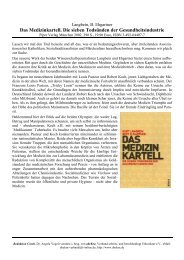Kinder besser schützen - Verband arbeits- und. berufsbedingt ...
Kinder besser schützen - Verband arbeits- und. berufsbedingt ...
Kinder besser schützen - Verband arbeits- und. berufsbedingt ...
Sie wollen auch ein ePaper? Erhöhen Sie die Reichweite Ihrer Titel.
YUMPU macht aus Druck-PDFs automatisch weboptimierte ePaper, die Google liebt.
<strong>Kinder</strong> <strong>besser</strong> <strong>schützen</strong><br />
GINSBERG, G., HATTIS, D., SONAWANE, B., RUSS, A., BANATI, P., KOZLAK, M.,<br />
SMOLENSKI, S. & GOBLE, R., 2002. Evaluation of child/adult pharmacokinetic<br />
differences from a database derived from the therapeutic drug literature. Toxicological<br />
Sciences, 66, 185–200.<br />
GLADEN, B.C. & ROGAN, W.J., 1995. DDE and shortened duration of lactation<br />
in a northern Mexican town. American Journal of Public Health 85, 504-508.<br />
GLADEN, B.C., RAGAN, N.B. & ROGAN, W.J., 2000. Pubertal growth and development<br />
and prenatal and lactational exposure to polychlorinated biphenyls<br />
ans dichlorodiphenyl dichloroethene. Journal Pediatrics 93, 490-496.<br />
GLINIANAIA, S., RANKIN, J., BELL, R., PLESS-MULLOLI, T. & HOWEL, D. 2004.<br />
Does particulate air pollution contribute to infant death? Environmental Health<br />
Perspectives, 112(14),1365-1370.<br />
GOLDSMITH, J.R., 1997. Dibromchloropropane: epidemiological findings and<br />
current questions. Annals of the New York Academy of Sciences 837, 300-306.<br />
GOYER, R.A., 1996. Toxic Effects of Metal. In: Klaasren, C.D. et al (Hrsg.): Casarett<br />
<strong>und</strong> Doull’s Tocixology. The basic Science of Poisons. 5. Aufl., McGraw-<br />
Hill, 691-736.<br />
GRANDJEAN, P., 1992. Individual susceptibility to toxicity. Toxicology Letters,<br />
64-65, 43-51.<br />
GRANDJEAN, P., WEIHE, P., WHITE, R.F., DEBES, F., ARAKI, S., YOKOYAMA, K.,<br />
MURATA, K., SORENSEN, N., DAHL, R. & JORGENSEN, P.J., 1997. Cognitive deficit<br />
in 7-year-old children with prenatal exposure to methylmercury. Neurotoxicology<br />
and Teratology, 19(6), 417-28.<br />
GRANDJEAN, P., MURATA, K., BUDTZ-JØRGENSEN, E.& WIHE, P., 2004. Cardiac<br />
autonomic activity in methylmercury neurotoxicity: 14-Year Follow-up of<br />
a Faroese birth cohort. Journal of Paediatrics, 144, 169-176.<br />
GRAY, R., PETO, R., BARNTON, P. & GRASSO, P., 1991. Chronic nitrosamine<br />
ingestion in 1040 rodents: the effect of choice of nitrosamines, the species studied,<br />
and the age of starting exposure, Cancer Research 51, 6470-6491.<br />
GRAY, L.E. JR., OSTBY, J., FURR, J., PRICE, M., VEERAMACHANENI, D.N. &<br />
PARKS, L., 2000. Perinatal exposure to the phthalates DEHP, BBP, and DINP, but<br />
not DEP, DMP, or DOTP, alters sexual differentiation of the male rat. Toxicological<br />
Sciences, 58, 350-365.<br />
GREATER BOSTON PHYSICIANS FOR SOCIAL RESPONSIBILITY, 2003. In Harm’s<br />
Way. unter: http://psr.igc.org/ihwpp2.ppt (Stand: August 2006)<br />
GREENPEACE, 2005. A Present for Life: Gefährliche Chemikalien im Nabelschnurblut.<br />
Zusammenfassung der Studie von WWF u. Greenpeace, Hamburg, 3 S.<br />
GRUBER, L., WOLZ, G. & PIRINGER, O., 1998. Untersuchung von Phthalaten in<br />
Baby-Nahrung. Deutsche Lebensmittelr<strong>und</strong>schau 94, 177-179.<br />
GUILLETTE, E.A., MEZA, M.M., AQUILAR, M.G., SOTO, A.D. & ENEDINA, I., 1998.<br />
An anthropological approach to the evaluation of preschool children exposed<br />
to pesticides in Mexico. Environmental Health Perspectives, 106, 347-353.<br />
GULSON, B.L., MIZON, K.J., KORSCH, M.J., PALMER J.M. & DONNELLY J.B.,<br />
2003. Mobilization of lead from human bone tissue during pregnancy and lactation<br />
- a summary of long-term research. Science of the Total Environment<br />
303, 79-104.<br />
GUO, Y.L., LAI, T.J. & JU, S.H., 1993. Sexual developments and biological findings<br />
in Yuchengf children. In: Fiedler, H.; Frank, H. Hutzinger, O.; Parzefall, W.;<br />
Riss, A.; Safe, S. (Hrsg.): Organohalogen Compo<strong>und</strong>s, 14. Aufl., Federal Environmental<br />
Agency, 235-238.<br />
GUO, Y.L., HSU, P.C. & HSU, C.C., 2000. Semen quality after prenatal exposure<br />
to polychlorinated biphenyls and dibenzofurans. Lancet 356, 1240-1241.<br />
GUO, Y.L., LAMBERT, G.H., HSU, C.C., HSU. M.M., 2004. Yucheng: Health effects<br />
of prenatal exposure to polichlorinated biphenyls and dibenzofurans. Int<br />
Arch Occ Environ Health. Appr 77(3): 152-158<br />
66<br />
GUPTA, A., AGARWAL, R. & SHUKLA, G.S., 1999. Functional impairment of<br />
blood-brain barrier following pesticide exposure during early development in<br />
rats. Human and Experimental Toxicology 18, 174-179.<br />
HALLGREN, S., SINJARI, T., HAKANSSON, H. & DARNERUD, P.O., 2001. Effects<br />
of polybrominated diphenyl ethers (PBDEs) and polychlorinated biphenyls<br />
(PCBs) on thyroid hormone and vitamin A levels in rats and mice. Archives of<br />
Toxicology Jun 75(4), 200-208.<br />
HANSEN, J.C., TARP, U. & BOHN, J., 1990. Prenatal exposure to methylmercury<br />
among greenlandic polar Inuits. Archives of Environmental Health 45,<br />
355-358.<br />
HARDY, M.L., 2002. The toxicology of the three commercial polybrominated<br />
diphenyl oxide (ether) flame retardants. Chemosphere 46(5),757-777.<br />
HATTIS, D., GINSBERG, G., SONAWANE, B., SMOLENSKI, S., RUSS, A., KOZLAK,<br />
M. & GOBLE R., 2003. Differences in pharmacokinetics between children and<br />
adults-II. Children’s variability in drug elimination half-lives and in some parameters<br />
needed for physiologically-based pharmacokinetic modeling. Risk Analysis<br />
23, 117-142.<br />
HEINEMEYER, G. & GUNDERT-REMY, U., 2002. Exposition von <strong>Kinder</strong>n<br />
gegenüber Pflanzenschutzmitteln. Abschlussbericht zu einem FuE-Vorhaben im<br />
Auftrag des Umweltb<strong>und</strong>esamtes (FKZ: 201 61 218/01); Hrsg. B<strong>und</strong>esinstitut<br />
für ges<strong>und</strong>heitlichen Verbraucherschutz <strong>und</strong> Veterinärmedizin, Berlin.<br />
HELBICH, H.M., 1999. Polychlorierte Biphenyle. In: Umweltmedizin. Hrsg. V.<br />
Mersch-S<strong>und</strong>ermann. Stuttgart: Georg Thieme-Verlag 1999, 215-217.<br />
HERBST, A.L., ULFELDER, H. & POSKANZER, D.C., 1971. Adenocarcinoma of the<br />
vagina. Association of maternal stilbestrol therapy with tumor appearance in<br />
young women. New England Journal of Medicine 284, 879-881.<br />
HERBST, A.L., 1999. Diethylstilbestrol and adenocarcinoma o the vagina.<br />
American Journal of Obstetrics and Gynecology, 181, 1576-1578.<br />
HERMAN-GIDDENS M.E., SLORA, E.J., WASSERMAN, R.C., BOURDONY, C.J.,<br />
BHAPKAR, M.V., KOCH, G.G. & HASEMEIER, C.M., 1997. Secondary sexual characteristics<br />
and menges in young girls seen in office practice. Pediatrics 89,<br />
505-512.<br />
HOLLADAY, S. & SMIALOWICZ, R., 2000. Development of the murine and<br />
human immune system: differential effects of immunotoxicants depend on<br />
time of exposure. Env. Health Persp. 108 (Suppl. 3), 463-473.<br />
HORNIG, M., 2004. Evidence to the US Institute of Medicine, vaccines and<br />
autism. See www.iom.edu/project.asp?id=4705 and see Michael Day, UK S<strong>und</strong>ay<br />
Telegraph 15 February 2004.<br />
HUISMAN, M., KOOPMAN-ESSEBOOM, C., FIDLER, V., HADDERS-ALGRA, M.,<br />
VAN DER PAAUW, C.G., TUINSTRA, L.G., WEISGLAS-KUPERUS, N., SAUER, P.J.,<br />
TOUWEN, B.C. & BOERSMA, E.R., 1995. Perinatal exposure to polychlorinated<br />
biphenyls and dioxins and its effect on neonatal neurological development.<br />
Early Hum Dev. 41(2), 111-27.<br />
HUMAN BIOMONITORING KOMMISSION DES UMWELTBUNDESAMTES, 1996.<br />
Stoffmonographie Blei - Referenz- <strong>und</strong> Human-Biomonitoring-Werte (HBM).<br />
Bekanntmachung des Instituts für Wasser-, Boden- <strong>und</strong> Lufthygiene des<br />
Umweltb<strong>und</strong>esamtes, B<strong>und</strong>esges<strong>und</strong>heitsblatt 39, 236-241.<br />
HUMAN BIOMONITORING KOMMISSION DES UMWELTBUNDESAMTES, 1999.<br />
Stoffmonographie PCB - Referenzwerte für Blut. Empfehlung, Instituts für<br />
Wasser-, Boden- <strong>und</strong> Lufthygiene des Umweltb<strong>und</strong>esamtes, Kommission<br />
"Human-Biomonitoring" des Umweltb<strong>und</strong>esamtes. B<strong>und</strong>esges<strong>und</strong>heitsbl -<br />
Ges<strong>und</strong>heitsforsch - Ges<strong>und</strong>heitsschutz 42, 6 (1999) 511-521.<br />
HUMAN BIOMONITORING KOMMISSION DES UMWELTBUNDESAMTES, 2003.<br />
Neue Referenzwerte für PCB-138,-153, -180 sowie für HCB, HCH <strong>und</strong> DDE im<br />
Vollblut. Umweltmedizinischer Informationsdienst 1, 8-11.<br />
ILSEN, A., BRIET, J.M. & KOPPE, JG., 1996. Signs of enhanced neuromotor<br />
maturation in children due to perinatal load with backgro<strong>und</strong> levels of dioxins.<br />
Chemosphere 33(7), 1317-1326.



